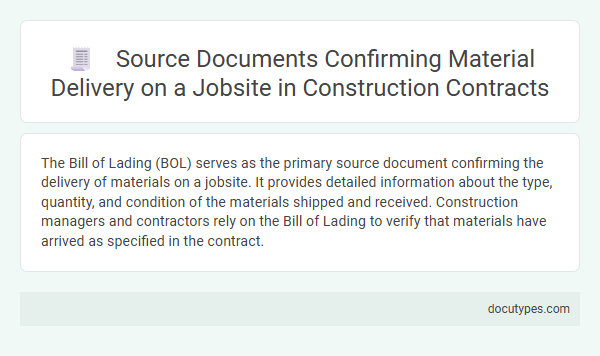The Bill of Lading (BOL) serves as the primary source document confirming the delivery of materials on a jobsite. It provides detailed information about the type, quantity, and condition of the materials shipped and received. Construction managers and contractors rely on the Bill of Lading to verify that materials have arrived as specified in the contract.
Introduction to Source Documents in Construction Contracts
| Introduction to Source Documents in Construction Contracts | |
|---|---|
| Definition | Source documents in construction contracts are official records that provide evidence and verification of project activities, transactions, and material deliveries on a jobsite. |
| Purpose | They confirm contractual compliance, track progress, and support financial and legal accountability during construction projects. |
| Which Source Document Confirms Material Delivery on a Jobsite? | |
| Delivery Ticket (Material Delivery Receipt) | This document serves as the primary evidence confirming the arrival of construction materials on-site. It includes specifics such as delivery date, quantities, material descriptions, and supplier information. |
| Bill of Lading | Often accompanies material shipments, detailing the transfer of goods and providing legal proof of delivery from the carrier to the receiver at the jobsite. |
| Inspection Reports | Created by quality control personnel to verify that delivered materials meet contractual specifications, confirming acceptance on-site. |
Importance of Material Delivery Confirmation
The source document that confirms material delivery on a jobsite is the Delivery Receipt or Bill of Lading. This document provides proof that the specified materials have arrived as ordered, ensuring accountability and transparency.
Material delivery confirmation is crucial for maintaining accurate project records and preventing disputes. Without this verification, delays and errors can affect timelines, costs, and overall project success, impacting Your contract obligations.
Common Types of Source Documents for Material Delivery
Source documents confirming material delivery on a jobsite include delivery receipts, packing lists, and bills of lading. Delivery receipts provide proof of materials received, signed by the site manager or receiving personnel. Packing lists detail the contents of shipments, while bills of lading serve as legal documents verifying carrier responsibility and delivery status.
Delivery Receipts and Their Role in Contract Compliance
Delivery receipts serve as a critical source document confirming material delivery on a jobsite, ensuring transparency and accuracy in contract execution. These receipts provide verifiable proof that materials have arrived as agreed upon, supporting legal and operational requirements.
- Delivery Receipts as Proof - They document the exact time, date, and quantity of materials delivered to the jobsite.
- Contract Compliance Evidence - Delivery receipts help verify that suppliers and contractors meet contractual delivery obligations.
- Dispute Prevention - Maintaining clear delivery records minimizes misunderstandings and supports resolution if disagreements arise.
Accurate delivery receipts are essential for maintaining accountability and transparency throughout the construction process.
Bills of Lading as Evidence in Construction Projects
In construction projects, confirming material delivery on a jobsite is crucial for contract adherence and payment processes. Bills of Lading serve as the primary source document that verifies the receipt of materials at the specified location.
- Legal Proof - Bills of Lading act as legally recognized evidence that materials were shipped and delivered to the jobsite, supporting contract terms.
- Delivery Details - These documents provide detailed information such as quantities, descriptions, and delivery dates, crucial for verifying your material receipts.
- Dispute Resolution - Bills of Lading play a key role in resolving disputes by serving as concrete proof of what was delivered versus what was ordered or invoiced.
Material Inspection Reports and Site Acceptance Forms
The primary source documents confirming material delivery on a jobsite are Material Inspection Reports and Site Acceptance Forms. Material Inspection Reports provide detailed verification of the quality and condition of materials upon arrival, ensuring they meet contract specifications. Site Acceptance Forms document your approval of the materials, confirming that they have been received and accepted at the jobsite.
Digital Solutions for Tracking Material Deliveries
The primary source document confirming material delivery on a jobsite is the delivery receipt or bill of lading. These digital documents provide accurate, timestamped records of materials received, enhancing accountability and transparency.
Digital solutions like mobile apps and cloud-based platforms streamline tracking by capturing real-time delivery confirmations and electronic signatures. You can improve project management efficiency and reduce disputes with these automated tracking tools.
Responsibilities for Document Management on the Jobsite
The delivery of materials on a jobsite is confirmed by the delivery ticket or bill of lading, which serves as the primary source document. Responsibilities for document management on the jobsite include accurate recording, secure storage, and prompt distribution of these documents.
- Delivery Ticket - Confirms materials received with details such as quantity, type, and delivery date.
- Document Recording - Ensures all delivery information is logged correctly to track material usage and inventory.
- Secure Storage - Protects delivery documents from loss or damage, maintaining accountability throughout the project.
Legal Implications of Inadequate Source Documentation
Which source document confirms material delivery on a jobsite? The delivery receipt or bill of lading typically serves as the primary source document verifying material arrival. Inadequate source documentation can lead to legal disputes regarding ownership, payment obligations, and project delays due to lack of proof of delivery or material condition upon arrival.
Which Source Document Confirms Material Delivery on a Jobsite? Infographic

